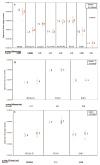Characterization and gene expression profiling in glioma cell lines with deletion of chromosome 19 before and after microcell-mediated restoration of normal human chromosome 19
- PMID: 19544381
- PMCID: PMC3190979
- DOI: 10.1002/gcc.20688
Characterization and gene expression profiling in glioma cell lines with deletion of chromosome 19 before and after microcell-mediated restoration of normal human chromosome 19
Abstract
Nearly 10% of human gliomas are oligodendrogliomas. Deletion of chromosome arm 19q, often in conjunction with deletion of 1p, has been observed in 65-80% of these tumors. This has suggested the presence of a tumor suppressor gene located on the 19q arm. Chromosome 19 deletion is also of interest due to the better prognosis of patients with deletion, including longer survival and better response to chemotherapy, compared with patients without deletion. Two glioma cell lines with deletion of 19q were used for chromosome 19 microcell-mediated transfer, to assess the effect of replacing the deleted segment. Complementation with chromosome 19 significantly reduced the growth rate of the hybrid cells compared with the parental cell lines. Affymetrix U133 Plus 2.0 Gene Chip analysis was performed to measure and compare the expression of the chromosome 19 genes in the chromosome 19 hybrid cell lines to the parental cell line. Probes were considered significantly different when a P value <0.01 was seen in all of the cell line comparisons. Of 345 probes within the commonly deleted 19q region, seven genes (APOE, RCN3, FLJ10781, SAE1, STRN4, CCDC8, and BCL2L12) were identified as potential candidate genes. RT-PCR analysis of primary tumor specimens showed that several genes had significant differences when stratified by tumor morphology or deletion status. This suggests that one or more of these candidates may play a role in glioma formation or progression.
(c) 2009 Wiley-Liss, Inc.
Figures



References
-
- Adachi J, Ohbayashi K, Suzuki T, Sasaki T. Cell cycle arrest and astrocytic differentiation resulting from PTEN expression in glioma cells. J Neurosurg. 1999;91:822–830. - PubMed
-
- Altman SA, Randers L, Rao G. Comparison of trypan blue dye exclusion and fluorometric assays for mammalian cell viability determinations. Biotechnol Prog. 1993;9:671–674. - PubMed
-
- Astbury C, Jackson-Cook CK, Culp SH, Paisley TE, Ware JL. Suppression of tumorigenicity in the human prostate cancer cell line M12 via microcell-mediated restoration of chromosome 19. Genes Chromosomes Cancer. 2001;31:143–155. - PubMed
-
- Ballman KV, Grill DE, Oberg AL, Therneau TM. Faster cyclic loess: Normalizing RNA arrays via linear models. Bioinformatics. 2004;20:2778–2786. - PubMed
-
- Barbashina V, Salazar P, Holland EC, Rosenblum MK, Ladanyi M. Allelic losses at 1p36 and 19q13 in gliomas: Correlation with histologic classification, definition of a 150-kb minimal deleted region on 1p36, and evaluation of CAMTA1 as a candidate tumor suppressor gene. Clin Cancer Res. 2005;11:1119–1128. - PubMed
MeSH terms
Substances
Grants and funding
LinkOut - more resources
Full Text Sources
Other Literature Sources
Miscellaneous

